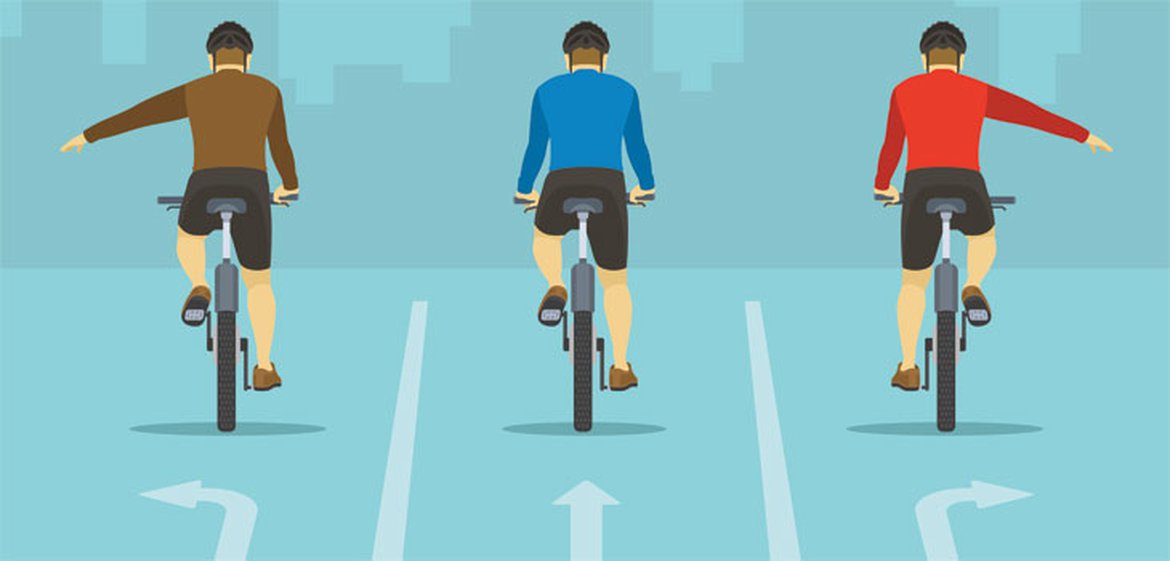Hands Up! What Cycling Signals Can Teach Us About Communication
July 31, 2025

Those technology wizards…every other day, it seems, they come up with another newfangled device.
Case in point: the cycling helmet intercom.
I didn’t even know such a thing existed. But this past May, when our Vancouver friends, Rob and Sylvia, joined us for a week of cycling in the Dordogne, sure enough, they had these in tow.
As Rob and Sylvia explained to the rest of us Luddites, helmets with built-in intercoms allow them to chat easily with one another, whether pedaling along flat roads, grinding up a mountain, or whizzing down the other side. Theirs are made by a company called Sena, most famous for their motorcycle helmets.
“We LOVE these helmets,” Sylvia told me. “Being able to communicate warnings of oncoming traffic, cars pulling out of driveways, holes, debris or bumps in the road, and direction of the next turn, all without yelling, is a great safety feature.”
I can see the appeal. To ride in a road group, even a “group” of two, you need to communicate. All the time. That’s because serious cyclists usually ride in a “pace line” which means one rider’s front wheel is just a few centimeters behind the rider in front’s back wheel.
Which is why hand signals have always been so important for cyclists.
You signal your turns (just as you would—or should—when driving a car). You signal that you’re stopping or slowing down. You point out hazards on the road – like glass (eek!!), potholes (double eek!!), loose gravel or broken pavement. You also point out railway crossings and cattle guards – both can topple the unsuspecting rider—as well as people, cars or any other large obstacle sitting in the lane ahead.
All of this is necessary because the rider behind in the pace line is very much visually compromised.
And what does this little lesson on cycling hand signals tell us about communication? Let me count the (five) ways.
1. Rules are good.
In the best of cases, rules exist for a reason. In cycling, this standard set of hand signals is intended to make the ride as safe, smooth and enjoyable as possible. Without these signals, you could easily have chaos and confusion.
Many people think grammar rules are annoying or unnecessary. But, like cycling hand signals, grammar rules serve a purpose. They help make our writing clear, consistent, accurate and precise. Without the rules, we would have a lot more misunderstandings, the writing equivalent of road chaos.
2. Clarity is paramount.
Even amateur cyclists can get moving pretty fast. Often, there’s little time to think or react. Simple, straightforward gestures are what’s needed: they can be quickly delivered and just as quickly understood.
The same goes for writing. As anyone who has taken my writing workshops knows, I’m an advocate of “plain language.” Plain language is not dumbed down language. Rather, it’s communication that is so clear—in wording, structure and design—that intended readers not only can find the information they need, but also understand and use that information. In the wise words of a 19th century Scottish sheriff: “Good drafting says in the plainest language, with the simplest, fewest, and fittest words, precisely what it means.”
3. Consistency builds trust.
When riders see the same hand signals over and over again, they learn to rely on them. Predictability is not only efficient, it also builds trust.
Corporate writers should also strive for consistency: consistency in style and consistency in messaging. Having a house style, actually codified in a company “style guide,” saves you time and effort. You’re not consistently questioning what to do or reinventing as you go.
A style guide also reinforces an organization’s brand. As does consistent messaging. It’s not enough to communicate an idea or message once, or even twice. For a message to stick with readers, you have to say it over and over and over and over again. Repetition builds trust, understanding and loyalty.
4. The message dictates the medium—and the content.
As much as cyclists rely on hand signals, sometimes the situation calls for something more drastic. Broken glass, say, or a car about to turn into your path. In those cases, you’d probably want to yell. (Or, as Danilo, our favourite Italian cycling guide, does: slap your thigh in emphatic and exaggerated fashion.)
Similarly, with communications, one size does not fit all. Good communicators need to be flexible, adapting their approach to the audience and the situation. The medium you chose for your communication depends, first and foremost, on your reader. The type of “document” you create, and the content of that document should fit the reader—her needs and characteristics, why she’ll be reading, and the context in which she’ll be reading.
5. Courtesy counts.
On a group ride, it’s prudent—and at a minimum, courteous—to pass the hand signals down the line from rider to rider so everyone is aware of what’s going on. It’s also nice to acknowledge other riders out on the road with a little nod, a wave, or a lift of a finger. And finally, to reinforce good behavior, it’s not uncommon for a cyclist to give the thumbs up to a motorist who stops or slows so we vulnerable, two-wheelers can safely clear an intersection or roundabout.
When it comes to communicating, it probably goes without saying that we should similarly strive to be courteous. But in this age of polarized opinions and online vitriol, I’ll say it anyway. Be nice! Be kind! Be respectful! As the old saying goes, “You catch more flies with honey than with vinegar.”
Remember this:
Effective communication relies on rules, clarity, consistency, adaptability and courteousness. Just like cycling hand signals.
